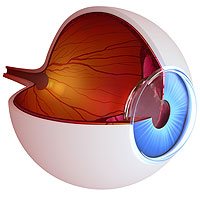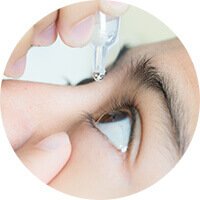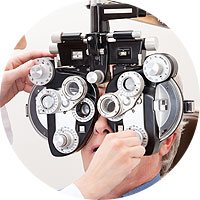PRK (photorefractive keratectomy) was the first procedure performed using the excimer laser. It corrects vision by reshaping the cornea. The difference between LASIK and PRK is that with LASIK, a corneal flap is created and the laser is applied to the inner tissue of the cornea. With PRK, the epithelium (or outer skin of the cornea) is removed and a laser is applied to the surface of the cornea. PRK can be used to correct low to high levels of nearsightedness, farsightedness, and astigmatism.
To treat nearsightedness, the steep cornea is made flatter by removing tissue from the center of the cornea. This moves the point of focus from in front of the retina to directly on the retina.
To treat farsightedness, the flat cornea is made steeper by removing tissue outside of the central optical zone of the cornea. This moves the point of focus from behind the retina to directly on the retina.
To treat astigmatism, the cornea is made more spherical — like a basketball instead of a football. This eliminates multiple focusing points within the eye and creates one point of focus on the retina. Astigmatism can be treated at the same time as nearsightedness and farsightedness.
Do you want to find our if you’re a candidate?
Schedule your FREE Laser Vision Correction Consultation Online!
View Video
What is the Difference Between LASIK and PRK?
Both LASIK and PRK use an excimer laser to reshape your cornea (the outer surface of your eye), allowing light to focus properly. With LASIK, our ophthalmologists will create a thin flap in your cornea so that the laser can reshape the tissue underneath. PRK does not require the creation of a flap. Instead, our ophthalmologists will use a laser to reshape the surface of your cornea. The healing time for PRK is slightly longer than for LASIK, but both procedures can achieve excellent vision correction results.
Why Should I Consider PRK Instead of LASIK
While LASIK is an excellent way to improve the quality of your vision, the procedure is not for everyone. If your corneas are too thin or your pupils are too large, it may rule you out as a candidate for LASIK. However, these factors do not impact your candidacy for PRK, making it an excellent alternative. The best way to find out if PRK is the right option for you is to schedule a consultation at our Northeastern Pennsylvania ophthalmology office.
Is PRK Painful?
Our doctors will administer a mild sedative and topical anesthetic prior to your procedure to minimize any discomfort. At most, you may experience a slight pressure on your eyes during your PRK procedure. It is common to experience some scratchiness during the recovery process. PRK has been approved by the FDA for use in vision correction procedures since 1995. The procedure is very safe, and complications are extremely rare.
Am I a Candidate for PRK?
There are several factors that may rule you out as a candidate for PRK. Patients with certain conditions such as vascular disease, keratoconus, immunodeficiency, or autoimmune disease are not good candidates for the procedure. PRK is also not a great option for individuals who form excessive scar tissue (keloids).
If you are pregnant or nursing, you will need to wait until this is completed to move forward with PRK. Also, PRK cannot be performed while taking certain medications such as:
- Accutane
- Cordorone
- Imitrex
- Steroids
Often, PRK is an excellent alternative for patients who are not suitable candidates for LASIK.
During your initial consultation, our ophthalmologists will thoroughly examine the condition of your eyes to determine whether PRK is the best vision correction solution for you.
Who is NOT a candidate for PRK?
There are several factors that may rule you out as a candidate for PRK. Patients with certain conditions such as vascular disease, keratoconus, immunodeficiency, or autoimmune disease are not good candidates for the procedure. PRK is also not a great option for individuals who form excessive scar tissue (keloids).
If you are pregnant or nursing, you will need to wait until this is completed to move forward with PRK. Also, PRK cannot be performed while taking certain medications such as:
- Accutane
- Cordorone
- Imitrex
- Steroids
Your PRK Procedure
You will arrive at our Northeastern Pennsylvania ophthalmology office about an hour prior to your procedure. Once you have been checked in, you may be offered a sedative to help you relax. You will then be prepared for surgery. The area around your eyes will be cleaned and a sterile drape may be applied around your eye.
Anesthetic eye drops will be used to numb your eyes; no injections or needles will be used. When your eye is completely numb, an eyelid holder will be placed between your eyelids to keep you from blinking during the procedure.
Your PRK procedure will generally take less than five minutes to complete. During the procedure, your doctor will remove the epithelium, a thin layer of protective skin that covers the cornea. You will be asked to look directly at a target light while the laser reshapes your cornea. The laser will be programmed with the information gathered in your pre-operative exam. The laser treatment will be completed in less than a minute or two, depending on the amount of correction needed.
Following your PRK procedure, your eyes will be examined with a slit lamp microscope. Your eyes may be shielded for protection. Your vision may be somewhat blurry or hazy for up to 7 days. You may experience some discomfort as the epithelium heals and covers the treated area.
Eye drops, pain medication, and possibly a protective contact lens can be used to minimize this discomfort. Most patients resume normal activities within one to three days. Vision can fluctuate for up to three months.
Once the recovery period is over you will get the opportunity to experience the world with clear, improved eyesight. Your dependence on glasses or contact lenses will be greatly reduced.
What is the Recovery From PRK Like?
Recovery time after PRK can last from four days to a week. The more you are able to keep your eyes closed during the recovery period, the faster they will heal. After your procedure, our ophthalmologists will provide you with detailed postoperative instructions. It is important to follow these carefully in order to ensure your eyes heal properly.
You can generally return to work within 24 hours of your procedure, but it is best to avoid strenuous activities for a week or two. We also recommend that you wear sunglasses during the recovery period in order to protect your eyes.

















